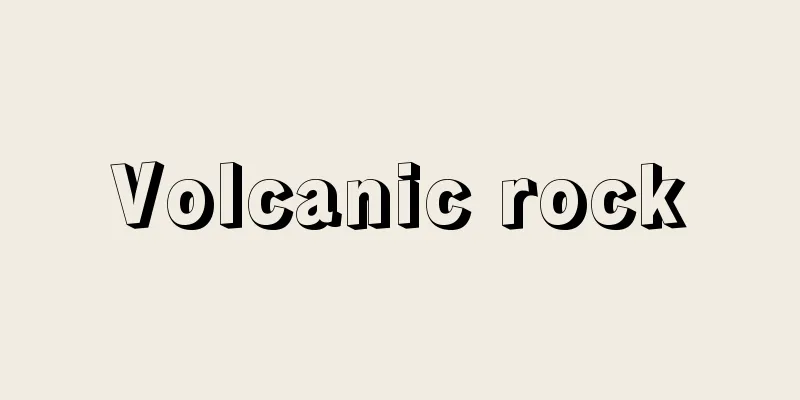Volcanic rock

|
Igneous rock formed when high-temperature magma, mainly composed of silicates, erupts on the earth's surface. It is also called extrusive rock. Volcanic rocks can also include volcanic products composed mainly of carbonates, sulfur, and sulfides. In other words, volcanic rock is a general term for lava formed when magma passes through a volcanic conduit and flows out of the crater to the earth's surface, various volcanic products formed when magma is released into the air or water, and pyroclastic rocks formed by the accumulation of these. It is often unclear whether the rocks erupted on the earth's surface or penetrated into the volcano's body, and they are often continuous, so igneous rocks formed near the earth's surface due to volcanic activity, including dikes, are sometimes treated as volcanic rocks. When hot magma rises rapidly from deep underground to the surface, the surrounding pressure suddenly drops, causing an effervescent effect, just like when you remove the cork from a bottle of soda, which promotes the formation of numerous gas bubbles and at the same time causes the magma to explode due to the pressure of the gas. This is the cause of various volcanic emissions. The ratio of solid, liquid, and gas phases in the hot material pushing up the vent from the magma chamber is the most important factor in determining the type of volcanic eruption, and the way in which volcanic rocks solidify is determined by this factor and external factors such as whether the eruption site is on land or on the sea. If the gas content is relatively low and it is pushed slowly to the surface, it becomes lava. If this magma flows slowly down while solidifying in seawater (land water), it becomes pillow lava (also called tawaraiwa or kurumaiwa), and in front of this, hyaloclastite (paragonite), which is made up of volcanic glass fragments formed when the lava surface cools rapidly, is formed. The surface shape of lava on land varies depending on the chemical composition and cooling conditions, and it is classified as aa lava, rope-like lava, pahoehoe lava, massive lava, etc. Based on the formation, size, distribution, and deposition state of the ejecta, volcanic ejecta can be classified as airfall (ejection) or land flow, which can be further subdivided into underwater deposits and land deposits. Airborne fallout is characterized by a regular distribution of particle sizes that spreads eastward from the crater, due to the initial velocity at the time of crater ejection and the westerly wind conditions, but land-borne flow has an irregular distribution of particle sizes. When deposition areas are underwater, stratification and laminae are observed in the sediments, but land-borne deposits are chaotic and lack any visible stratification or laminae. [Toshihiko Yajima] Magma and volcanic emissionsVolcanic ejecta (clastic material) derived from magma can be divided into volcanic blocks (over 64 mm in diameter), lapilli (64-2 mm in diameter), and volcanic ash (under 2 mm) depending on their size. If they are still liquid when released into the air, they can assume various shapes during flight (spindle-shaped bombs, breadcrust-like bombs, lava cakes, Pele's hair, Pele's tears) and have specific internal structures (pumice with numerous air holes, scaly stone, etc.). Porous, glassy lapilli and similarly sized scaly stones (scoria) are also called cinders. Pisolites are volcanic ash that condense on raindrops in the smoke. Pyroclastic rocks are formed when volcanic debris accumulates and solidifies, and are classified as volcanic breccia, tuff breccia, lapilli tuff, tuff, tuff agglomerate, scaly agglomerate, pumice tuff, etc. Pyroclastic material can flow down the slope of a volcano at high speed while spewing hot steam (pyroclastic flow). The way in which magma solidifies and the type of volcanic eruption depend on the chemical composition of the magma, the temperature, and the ratio of liquid, solid, and gas phases in the ejecta. When magma cools and solidifies rapidly, there is no time for crystals to grow, so it becomes glassy (with irregularly arranged molecules) or a collection of tiny crystals. Acidic volcanic glass rich in silicon dioxide is called obsidian, perlite, or pitchstone, while mafic basic volcanic glass is called tachylyte. If magma already contains crystals before it erupts at the Earth's surface, it becomes phenocryst-like volcanic rock when it cools rapidly. The large crystals are called phenocrysts, and the fine-grained parts that fill the spaces between them are called groundmass. Once the chemical composition, temperature, and liquid/solid/gas ratio of the magma are determined, the properties of the volcanic rocks that are formed are largely determined, and the eruption style and shape of the volcano are also roughly determined. When a large amount of high-temperature, highly fluid lava overflows in all directions, it creates a flat lava plateau (Deccan Plateau, Columbia River Plateau, Patagonia Plateau, Gaima Plateau, etc.). Also, if the lava is mainly fluid and there is little release of volcanic debris, a shield volcano (Iceland, Hawaii, etc.) is formed. When lava outflow and release of volcanic debris are repeated alternately, a stratovolcano (Mt. Fuji) is formed. When a highly viscous felsic, relatively low-temperature semi-solid material is pushed out near the surface, a lava dome (Showa Shinzan) is formed. [Toshihiko Yajima] Distribution of volcanic rocksComparing the distribution area of various rocks in the Japanese archipelago, Quaternary and Tertiary volcanic rocks cover 86,250 square kilometers, making up the highest proportion at 23.3%, but if we also consider the ancient volcanic rocks in the Paleozoic and Mesozoic strata, the Japanese archipelago remains a volcanic country, both now and in the past. In the Japanese archipelago, there is a clear belt-like arrangement of volcanic rocks that follows the shape of the island arc. For example, in northeastern Japan, tholeiite, high alumina basalt, and alkali olivine basalt are arranged from the Pacific Ocean side toward the Sea of Japan side. This is thought to be because the depth of magma generation is deeper on the continental side, corresponding to the existence of a deep earthquake zone (Benioff Zone, or Wadachi-Benioff Zone) that slopes toward the continental side. [Toshihiko Yajima] [References] | | | | | |Source: Shogakukan Encyclopedia Nipponica About Encyclopedia Nipponica Information | Legend |
|
ケイ酸塩を主成分とする高温のマグマが地表に噴出して形成された火成岩。噴出岩ともいう。特殊なものとして、炭酸塩、硫黄(いおう)、硫化物などを主成分とする火山噴出物も火山岩に含めることもある。つまり火山岩とは、マグマがその通路である火道(かどう)を通過して、火口から地表に流出して形成された溶岩類、空中または水中に放出されて形成された各種火山噴出物、これらのものが堆積(たいせき)して形成された火山砕屑(さいせつ)岩(火砕岩)の総称である。地表に噴出したのか、火山体の内側に貫入しているのかは、不明であったり、連続的なものであったりすることが多いので、岩脈なども含めて地表近くで火山活動に伴って形成される火成岩を火山岩として扱うことがある。 高温のマグマが地下深所から急速に地表に上昇すると、周囲の圧力が急激に低下するために、ちょうどサイダーの栓を抜いたときのように発泡作用がおこり、多数の気泡の形成を促進すると同時に、ガスの圧力によってマグマを飛散させることになる。これが各種火山放出物の成因となる。マグマ溜(だま)りから火道を押し上げてくる高温物体中の固相・液相・気相の比率が火山噴火の様式を決めるもっとも重要な要素であり、火山岩の固結の仕方は、この要素と、噴出地点が陸上か海上かの外因的要素によって決まってくる。 もしもガス成分が比較的少なく、ゆっくりと地表に押し出されれば溶岩となる。このマグマが海水中(陸水中)を固結しながらゆっくりと流下すると枕状溶岩(まくらじょうようがん)pillow lava(俵岩(たわらいわ)、車岩ともよぶ)となり、この前面には溶岩表面が急冷してできた火山ガラスの破片よりなるハイアロクラスタイト(パラゴナイト)ができる。陸上の溶岩は化学組成、冷却条件などにより表面の形状が異なり、アア溶岩、縄状(なわじょう)溶岩、パホイホイ溶岩、塊状(かいじょう)溶岩などに分けられる。火山噴出物は、噴出物の形成、大きさ、分布、堆積状態などから判断して、空中降下物(放出物)、陸上流下物に分けられ、これらはさらに水中堆積物、陸上堆積物に細分される。空中降下物は、火口放出時の初速度と偏西風の条件などから、火口を中心として東側に広がった規則的粒度分布を示すのが特徴であるが、陸上流下物は、粒度分布が不規則である。堆積地域が水中であると、堆積物中に層理、葉理(ラミナ)が認められるのに対して、陸上堆積物は雑然としていて層理、葉理が認められない。 [矢島敏彦] マグマと火山放出物マグマに由来する火山放出物(砕屑物)は、大きさによって火山岩塊(直径64ミリメートル以上)、火山礫(れき)(直径64~2ミリメートル)、火山灰(2ミリメートル以下)に分けられる。空中放出時にまだ液状であると、空中飛行時に各種の形状となり(紡錘形火山弾、パン皮状火山弾、溶岩餅(べい)、ペレーの毛、ペレーの涙)、また特定の内部構造をもったりする(無数の気孔をもった軽石、岩滓(がんさい)など)。そのほか多孔質でガラス質の本質火山礫、あるいは同程度の大きさの岩滓(スコリア)を噴石とよぶことがある。火山豆(まめ)石(ピソライト)は、噴煙中の雨滴に火山灰が凝結したものである。火山砕屑物が堆積して固結したものが火山砕屑岩(火砕岩)であり、火山角礫岩、凝灰(ぎょうかい)角礫岩、火山礫凝灰岩、凝灰岩、凝灰集塊岩、岩滓集塊岩、軽石凝灰岩などに分けられる。火山砕屑物は、高温のまま水蒸気を噴出しながら高速で火山体斜面を流下することがある(火砕流)。これらのマグマの固結の仕方、火山の噴火形式は、マグマの化学組成、温度、噴出物中の液相・固相・気相の比率などによって決まる。 マグマが急速に冷却して固結すると、結晶が成長する時間的余裕がないためにガラス質(分子が不規則に配列している)、または微細な結晶の集合体となる。二酸化ケイ素に富む酸性の火山ガラスは黒曜石、真珠岩、ピッチストーンとよび、苦鉄質の塩基性火山ガラスをタキライトとよぶ。マグマが地表に噴出する以前にすでに結晶を含んでいる場合には、これが急冷すると斑晶(はんしょう)質の火山岩となる。大きな結晶を斑晶、間を埋めている細粒な部分を石基(せっき)とよぶ。 マグマの化学組成、温度、液相・固相・気相比が決まると、形成される火山岩の性質もほぼ決まり、火山の噴火形式、火山の形態もだいたい決まってくる。高温の流動性に富む溶岩が大量に四方にあふれ出すと、平坦(へいたん)な溶岩台地をつくる(デカン高原、コロンビア川台地、パタゴニア台地、蓋馬(かいま)高原など)。また、流動性に富む溶岩を主として火山砕屑物の放出が少なければ楯状(たてじょう)火山(アイスランド、ハワイなど)ができる。溶岩の流出と火山砕屑物の放出が交互に繰り返されると成層火山(富士山)ができる。粘性の大きな珪長(けいちょう)質で比較的低温の半固体状物質が地表付近に押し出してくると溶岩円頂丘(昭和新山)ができる。 [矢島敏彦] 火山岩の分布日本列島に分布する各種岩石の分布面積を比較すると、第四紀・第三紀火山岩は8万6250平方キロメートルで、23.3%の最高の比率を占めるが、古生代、中生代の地層中の古期火山岩を含めて考えると、日本列島は今も昔も火山国であることに変わりはない。日本列島では島弧の形状に沿った火山岩の帯状配列が顕著で、東北日本を例にとると、太平洋側からソレイアイト、高アルミナ玄武岩、アルカリ橄欖石(かんらんせき)玄武岩と日本海側に向かって配列している。大陸側に傾斜した深発地震面(ベニオフゾーン、または和達(わだち)‐ベニオフゾーン)の存在と対応して、マグマの発生深度が大陸側では深くなっているためと考えられている。 [矢島敏彦] [参照項目] | | | | | |出典 小学館 日本大百科全書(ニッポニカ)日本大百科全書(ニッポニカ)について 情報 | 凡例 |
>>: Benzoyl peroxide - benzoyl peroxide
Recommend
Gadsden, J.
...refers to the purchase of territory by the Uni...
Hans Eisler
German composer. Born in Leipzig. Studied under S...
treaty cruiser
… The Washington Treaty (1922) limited the number...
Fushimi Castle
Hirayama-jiro (castle on a flatland mountain) was ...
Valleys
An American composer born in France. After aspirin...
My Sin - Onogatsumi
A full-length novel by Kikuchi Yuho. The first par...
Meissner, FW (English spelling)
...This means that superconductors exhibit perfec...
Oncidium
A genus of the orchid family (APG classification:...
Altfelde, J. van - Altfelde
…Flemish statesman. Also read as Altevelde. A wea...
Crown (bottle) - Oukan
...However, the modern era can be considered to h...
yakṣa (English spelling) yaksa
…This goddess later becomes the protector of chil...
konda
...The Deccan Plateau stretches behind it, about ...
Modalism
…It emphasizes the unique activity of God the Fat...
Pinnaglobin
…Many enzymes are known to require manganese, inc...
Sallo, D.de (English spelling) SalloDde
… 【history】 The first periodical in the form of a...









